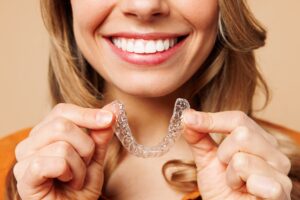Invisalign® vs. Braces
Posted on October 15, 2024 in Latest News, Orthodontics
 Treatment for orthodontic conditions has come a long way over the years. Today, there are more options than ever for patients of all ages to successfully straighten their teeth, improve their bite, and renew smile aesthetics with beautiful results. Many individuals are also now able to take advantage of treatments such as Invisalign® instead of traditional braces to meet their orthodontic needs, which utilizes a much different approach to orthodontic correction.
Treatment for orthodontic conditions has come a long way over the years. Today, there are more options than ever for patients of all ages to successfully straighten their teeth, improve their bite, and renew smile aesthetics with beautiful results. Many individuals are also now able to take advantage of treatments such as Invisalign® instead of traditional braces to meet their orthodontic needs, which utilizes a much different approach to orthodontic correction.
In today’s blog post, our experienced dentist in Markham, Dr. Susie Ang, explains some of the distinctions between these popular orthodontic treatments:
Invisalign®
Invisalign® offers an innovative orthodontic solution for both adults and teenagers alike. This option is capable of correcting mild to moderate misalignment concerns and bite irregularities without reliance on the metal or ceramic brackets and wires associated with traditional braces. Invisalign® utilizes a series of custom-designed aligners made of a translucent plastic material to progressively move the teeth into a better position. The aligners are removable for eating, drinking, and daily oral hygiene routines, and they are known to be more comfortable than braces. Arguably the most prominent advantage of Invisalign® is the virtually invisible nature of the aligners. The appliances are so thin and clear that others are not likely to notice them while they are in use.
Tooth position supports facial structure, so correction of orthodontic concerns can ultimately enhance the face. Dr. Ang uses Invisalign® as an advanced tool to achieve that objective. She designs a treatment plan that offers the best smile set-up for the individual patient. Her goal is for the smile to look natural and harmonize with the face.
With all of this in mind, not every individual is an ideal candidate for Invisalign®. A consultation with Dr. Ang can determine whether Invisalign® offers the ideal solution for one’s unique needs and goals.
Traditional Braces
Braces utilize a system of fixed brackets and wires to correct gaps, crowding, and other misalignment concerns. They can also be very effective for bite irregularities. When compared to Invisalign®, traditional braces are much more noticeable on the teeth, often take longer to provide optimal results, and typically require more ongoing maintenance. Additionally, they cannot be removed by the patient, and they can be more challenging for oral hygiene routines as food can get trapped between the brackets and wires. However, the fact that patients cannot remove the braces is actually seen as an advantage over Invisalign® by some individuals who would like to avoid the necessity of removing the aligners every time they eat or drink. Additionally, traditional braces can also be a more ideal option for younger patients who may have trouble complying with the Invisalign® treatment protocol, which requires the aligners to be worn throughout most of the day and changed out as scheduled. Advances in braces technology have also made some of the brackets a bit smaller, and patients often have a choice between metal braces and those made of ceramic or clear material that makes them more discreet on the teeth. With all of the potential drawbacks of braces, they have been successfully improving common orthodontic concerns for decades and offer an alternative for patients who may not be the best candidates for less invasive treatments such as Invisalign®.
The ideal choice for your needs can be determined during an initial consultation with Dr. Ang. If you are considering orthodontic treatment, please don’t hesitate to contact us today.
